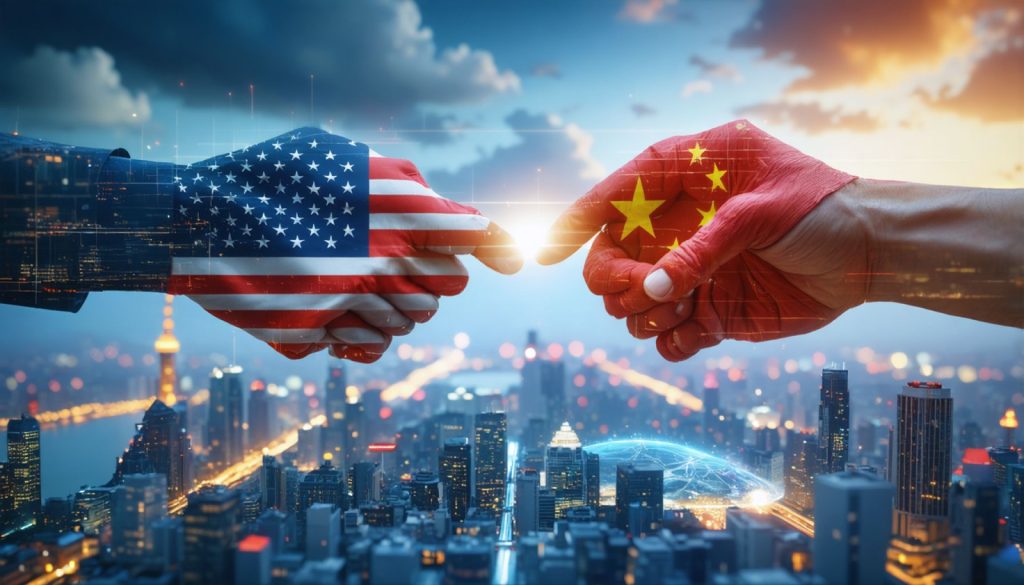
- The relationship between the United States and China is a complex blend of cooperation, competition, and contention, influencing global markets and technological advancements.
- Technological rivalry is evident in the race to dominate 5G technology, with the U.S. concerned about security risks and China’s rapid advancements challenging the status quo.
- The economic relationship features significant trade tensions, including tariff wars that affect industries and markets worldwide.
- Both nations hold a critical role in addressing global challenges, such as climate change, emphasizing the importance of diplomatic collaboration.
- While competition fosters innovation, collaboration between these superpowers is crucial for ensuring global stability and progress.
- The dynamics between the U.S. and China highlight the intricate balance of international relations, where every strategic move impacts the global landscape.
In today’s interconnected world, the dance of diplomacy between nations often feels like a high-stakes game of chess, where each move can trigger a cascade of repercussions. At the heart of this dynamic global stage lies the intricate relationship between two superpowers that shape the world’s economic and technological landscape: the United States and China.
The U.S.-China relationship can best be described as a complex tapestry, woven with strands of cooperation, competition, and often, contention. This intricate interplay significantly impacts global markets, technological advancements, and even cultural exchanges across the world.
The technological tug-of-war between these two nations showcases the push and pull of international relations. On one end, the United States leads in software development and innovation, with Silicon Valley standing as a symbol of American ingenuity and entrepreneurial spirit. On the other, China’s rapid advancements in fields like artificial intelligence and telecommunications challenge the status quo, setting up a fierce competition for technological supremacy.
This rivalry became especially pronounced with the race to dominate 5G technology. 5G promises to revolutionize connectivity with unprecedented speed, powering everything from smart cities to autonomous vehicles. The U.S. has expressed concerns over potential security risks associated with allowing Chinese companies to establish significant footprints in global 5G infrastructure. This highlights a growing mistrust, as well as the strategic interests each nation has in safeguarding their technological futures.
Beyond technology, the U.S. and China are also locked in economic ballet, with trade being a major cornerstone of their relationship. Tariff wars have seen duties imposed on billions of dollars’ worth of goods, affecting industries worldwide and causing ripples in the stock market. Every decision taken by these economic giants sends shockwaves through international markets, affecting everything from the price of metals to the trade strategies of small nations looking to carve out their own niches.
Moreover, this influence extends to global challenges like climate change, where both nations carry significant responsibility and power to lead. The controversial withdrawal and subsequent re-entry of the U.S. into international climate agreements illustrate the importance of diplomatic collaboration in facing worldwide threats.
The overarching takeaway? In this era of transformative global relations, collaboration is key. While competition drives innovation, cooperation ensures stability and progress. The U.S. and China, while often depicted as adversaries, have the potential to unlock harmonious partnership, one that could set a precedent for addressing complex global challenges.
International relations are not just about governmental policies or economic strategies; they compel us to reflect on how nations coexist, compete, and cooperate in a shared world. Like pieces on a chessboard, each move matters and reverberates through the intricate corridors of global diplomacy, shaping our collective future.
The High-Stakes Chess Game of U.S.-China Relations: What You Need to Know
The complex relationship between the United States and China impacts the entire globe, playing out like a high-stakes chess game with significant implications for technology, trade, and international diplomacy. As the two superpowers engage in this intricate dance, the outcomes reverberate through global markets and influence worldwide technological and economic developments.
Technological Rivalry and 5G Dynamics
Technological Leadership and Innovation
– The U.S. holds a leading position in software and technology innovation, with Silicon Valley serving as a hub for emerging tech companies and breakthroughs.
– China has made significant strides in artificial intelligence, telecommunications, and manufacturing, and its firms like Huawei and ZTE are at the forefront of 5G technology deployment.
5G Network Security Concerns
– The race to dominate 5G technology underscores the tension between these nations. The U.S. has raised security concerns over China’s 5G networks, fearing espionage and cyber threats.
– Countries worldwide must consider risks and benefits when choosing 5G partners, balancing technological advancement with security concerns. The European Union, for instance, has developed 5G security guidelines to mitigate risks associated with foreign technology reliance.
Economic Interdependence and Trade Tensions
Trade and Tariff Wars
– The U.S. and China have imposed tariffs affecting billions of dollars in goods, sending ripples through global supply chains. Key industries such as electronics, agriculture, and automobiles experience pricing volatility as a result.
– For businesses and investors, understanding tariff impacts and sourcing strategies are vital. Companies diversifying supply chains beyond China to Southeast Asia and other regions may find increased resilience against trade uncertainties.
Cultural and Educational Exchanges
– Despite economic tensions, educational and cultural exchanges continue to foster soft diplomacy. Chinese students comprise a significant portion of international students in the U.S., benefiting from top-tier education and contributing to campus diversity.
Global Challenges and Collaborative Opportunities
Climate Change Initiatives
– As the world’s largest carbon emitters, both the U.S. and China bear the responsibility and capability to lead climate initiatives. Collaborative efforts in renewable energy, such as solar and wind power, are crucial to meeting global emission targets.
– The re-entry of the U.S. into climate accords such as the Paris Agreement signifies a renewed commitment to global collaboration.
The Road Ahead: Cooperation and Innovation
While geopolitical tensions highlight competition, collaboration between the U.S. and China remains essential for global stability and progress. Enhanced cooperation can lead to advancements in technology, increased economic resilience, and joint solutions for climate change challenges.
Actionable Recommendations
– Diversify Supply Chains: Businesses should consider diversifying suppliers to mitigate risks from trade tensions and tariffs.
– Invest in Resilience: Companies investing in advanced technologies such as AI and cybersecurity can leverage innovation while safeguarding against geopolitical risks.
– Stay Informed: Keeping abreast of geopolitical developments and policy changes can help individuals and businesses make strategic decisions.
– Promote Sustainability: By supporting renewable energy initiatives, businesses and consumers can contribute to sustainability and climate goals.
Relevant Links
For more insights on international relations and economic trends, visit Council on Foreign Relations or Brookings Institution.
Recognizing the dynamic nature of U.S.-China relations, staying informed and adaptable is key to navigating this complex global landscape, much like mastering the intricate moves on a chessboard.



